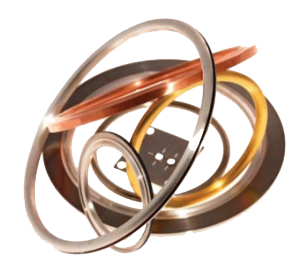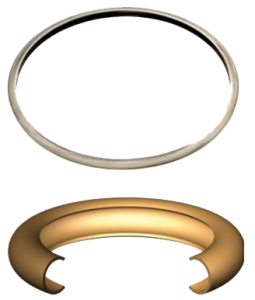
In a typical oil refinery or chemical processing plant, 60% of fugitive emissions are attributable to leaking valves. Of these, nearly 80% are released at valve stems. Also contributing to valve failures, are leaks at the bonnet, flanges and seats. As operating conditions in these and other industries continue to subject valves to ever more extreme temperatures and pressures, sealing them effectively poses a challenge that cannot be met with traditional materials and methods. Soft, compressible elastomers provide good sealing performance, but they are porous and cannot withstand temperatures in excess of 482°F (250°C). They also become hard and brittle in cryogenic service. Metal seals have much greater temperature capabilities, high mechanical properties, lack of porosity and long shelf life. Ductility and elasticity are typically the limiting factors.
Today more resilient, metal-to-metal seals are available and being used in valves operating under extreme conditions. Spring- and pressure-energized metal seals function much like a gasket between two flanges with little or no relative motion between them.

The sealing principle of spring-energized seals is based on plastic deformation of a jacket that is more ductile than the mating surface. This deformation occurs between the sealing face and an elastic core composed of a closely wound helical spring. The spring provides specific resistance to compression, during which the resulting pressure forces the jacket to yield and fill flange imperfections. Each coil of the helical spring acts independently, allowing the seal to conform to any surface irregularities. This combination of elasticity and plasticity provides an extremely effective seal even under the decompression cycles.
Pressure-energized seals include metal C-rings, O-rings, E-rings and U-rings. The sealing concept of C-rings is based on the elastic deformation of C-shaped metal substrates, the characteristics of which determine the compressive load of the seal. Combined with an accurate compression rate, this load results in specific pressure on the flange faces. A softer surface treatment such as silver plating can be applied to increase the plasticity of the seal and reduce the pressure required to reach a desired sealing level. C-rings typically open toward system pressure, which further energizes the seal to supplement load. This energizing effect increases in direct proportion to increases in differential system pressure.

Metal O-rings are designed for sealing high pressure/ temperature applications requiring minimal spring-back. They are made of high-strength metal tubing that is coiled, cut and welded to size. Sealing load can be adjusted by varying the cross section and wall thickness of the tubing. Basic metal O-rings are suitable for low to moderate pressure applications that will not collapse the tubing wall.
Also available are self-energizing O-rings for high-pressure service. These seals have small holes that allow system pressure to enter, minimizing the potential for tubing collapse. In addition, O-rings can be filled with inert gas that expands as the temperature increases, producing an energizing effect that partially offsets loss of material strength in service.
Metal E-rings are designed to provide low load and high spring-back performance in high pressure/ temperature applications. In service they are pressure energized by the system, which increases contact stress and minimizes leakage. The geometry of the seals can be designed to meet the requirements of specific applications.

U-rings, like E-rings, provide good spring-back, but have a smaller range of compression. However they can serve as a cost-effective solution for applications requiring more spring-back than a typical C-ring.
Valve applications
Resilient metal-to-metal seals are now being used in a number of valve applications, including body-bonnet connections, seats, pressure-balanced plugs, back-seat sealing and stem sealing. Butterfly valves traditionally have been sealed with soft materials, the limitations of which have been noted. High service temperatures, together with other requirements such as fire safety, extended lifetime cycles, chemical resistance and high sealing performance are being met by spring-energized metal seals, millions of which are now being used in butterfly valves throughout the world. In high temperature service, the sealing jacket material is typically nickel or Inconel®, and copper for cryogenic service. The seals allow bidirectional flow, and provide service lives in excess of 100,000 cycles.
Increasingly users are moving to triple offset butterfly valves for high-pressure applications ranging from 1,450 psi (100 bar) to 2,176 psi (150 bar). These include thinner profile, lighter weight, lower torque, tighter metal-to-metal sealing capability, and reduced wear for high cycle life and lower maintenance costs.
High-pressure, triple-offset butterfly valve seats are often sealed with solid machined metal seals for critical bidirectional applications, but laminated seals with alternating layers of metal and graphite provide greater elasticity and sealing effectiveness. These high-precision seals feature complex geometries that control graphite flow and withstand pressures up to 150 bar.
Double-offset butterfly valve seats likewise can be sealed with solid metal seals for high-pressure service to 100 bar. However spring-energized seals provide better performance at lower pressures to 50 bar. The spring compensates for displacement between the seat and disc due to thermal dilation or pressure. This makes the seals suitable for LNG, steam and other extreme services, where they provide high leak tightness and resistance over time. Laminated graphite and spring energized metal seals also can be used for sealing ball, globe, gate and Class 5 and 6 shutoff valves.
Body-bonnet connections in gate, globe, ball and plug valves have traditionally been sealed with spiral-wound, metal-graphite seals or cut gaskets. Unfortunately, these seals were designed for use in raised face joints, which preclude metal-to metal contact. Heat tended to relax the graphite, which required the joint to be continually re-torqued to the point where the seal became unwound and failed. Spring-energized and C-ring seals have proven to be a better solution for valves in high temperature/pressure services, requiring low emissions and involving some degree of joint movement. They also perform well at cryogenic temperatures.
Sealing pressure-balanced plugs in globe and Class 5 and 6 shutoff valves involves dynamic seals that move with the plug. Manufactured with holes to equalize pressure, these plugs reduce torque requirements, allowing the use of smaller actuators, but also introduce secondary leak paths. For valves in high-temperature service requiring low emissions, a dynamic spring-energized metal seal can be installed on top of the plug to prevent leakage to the external environment.
Back-seat sealing of metal-seated, trunnion-mounted ball valves poses a common problem in the industry. This practice typically serves a dual purpose, providing a seal between the body and seat and applying spring force against the seat and ball. Traditionally this has been done with Belleville washers, coiled springs or die-formed graphite, and in some cases no secondary seal is used for high-temperature applications. Depending on the amount of seat movement required, resilient metal seals such as spring-energized, E-rings, U-rings or C-rings can be used.
Valve stems, which as noted are the single largest source of fugitive emissions, continue to be sealed with graphite or PTFE compression packing. However, neither of these materials is suitable for cryogenic or high-temperature service in the presence of oxygen. Spring-energized metal seals for rotary, rising stem and linear valves provide full metal-to-metal contact, leak tightness to 10-5 atm cc/sec and accommodation of axial stem movement. Also available for sealing valve stems are special ring sets that control fugitive emissions and withstand the severe conditions of service in chemical, petrochemical and nuclear facilities.
Some of the applications mentioned involve dynamic or semi-dynamic sealing, for which metal seals are not typically suited. Proper material selection and coatings can reduce friction, improve wear performance and protect against corrosion. Coatings can consist of traditional gold, nickel or silver electroplating or more modern forms such as thermal sprays, PVD or CVD
Summary
Metal seals are used where other materials are unacceptable. Available in a wide range of sizes, they provide infinite storage life and long-term sealing with no porosity. They can withstand temperatures from -423°F to +2,200°F (-252°C to +1,204°C) in hard vacuum to high-pressure service. These properties make them the sealing solution of choice for valves operating in today’s increasingly extreme environments.
The original article was written by Kevin Lamb of the Technetics Group and can be found on their website.
For more information about metal seals, check out our other blogs. Or, speak to a GFS engineer today about the applications and how metal seals can benefit you.
